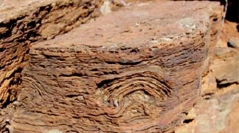

 Comptes Rendus Palevol
8 (7) - Pages 649-663
Comptes Rendus Palevol
8 (7) - Pages 649-663The Pilbara Craton of Western Australia and the Barberton Greenstone Belt of the Kaapvaal Craton, South Africa, contain some of the oldest and best preserved Archaean rocks and microfossils in the world. Two stratigraphic horizons in the Pilbara Craton were drilled as part of a collaborative effort between France and Australia (the Pilbara Drilling Project) during August 2004, including the 3481 Ma Dresser Formation (Warrawoona Group) and 2724 Ma Tumbiana Formation (Fortescue Group). A new diamond drill hole was cored in August 2008 through part of the ∼3250 Ma Fig Tree Group in the Barberton Greenstone Belt as part of a joint project between France and South Africa. These pristine diamond drill cores present a unique opportunity to constrain the chemistry of the earliest ocean, the composition of the atmosphere, and the settings and types of microbial ecosystems spanning the Archean Eon. These drill core samples can also provide new clues on the earliest metabolic pathways.
Archean, Early life, Diamond drill cores, Pilbara Craton, Barberton Belt, Stable isotopes